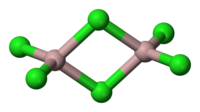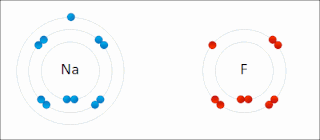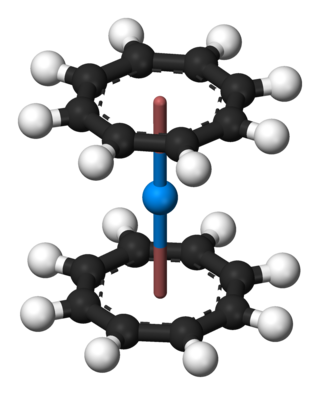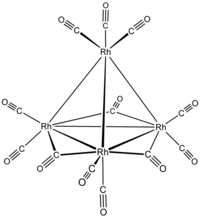Ligand names
Anionic ligands
If the anion name ends in -ide then as a ligand its name is changed to end in -o. For example the chloride anion, Cl− becomes chlorido. This is a difference from organic compound naming and substitutive naming where chlorine is treated as neutral and it becomes chloro, as in PCl3, which can be named as either substitutively or additively as trichlorophosphane or trichloridophosphorus respectively.
Similarly if the anion names end in -ite, -ate then the ligand names are -ito, -ato.
Neutral ligands
Neutral ligands do not change name with the exception of the following:
- Water, "aqua"
- Ammonia, "ammine"
- Carbon monoxide bonded via carbon, "carbonyl"
- Nitrogen monoxide bonded via nitrogen, "nitrosyl"
Examples of ligand names
| Formula | name |
|---|
| Cl− | chlorido |
| CN− | cyanido |
| H− | hydrido |
| D−or 2H− | deuterido or [2H]hydrido |
| PhCH2CH2Se− | 2-phenylethane-1-selenolato |
| MeCOO− | acetato or ethanoato |
| Me2As− | dimethylarsanido |
| MePH− | methylphosphanido |
| MeCONH2 | acetamide (not acetamido) |
| MeCONH− | acetylazanido or acetylamido (not acetamido) |
| MeNH2 | methanamine |
| MeNH− | methylazanido, or methylamido, or methanaminido |
| MePH2 | methylphosphane |
| CO | carbonyl |
Sequence and position of ligands and central atoms
Ligands are ordered alphabetically by name and precede the central atom name. The number of ligands coordinating is indicated by the prefixes di-, tri-, tetra- penta- etc. for simple ligands or bis-, tris-, tetrakis-, etc. for complex ligands. For example:
- [CoCl(NH3)5]Cl2 pentaamminechloridocobalt(3+) chloride where ammine (NH3)precedes chloride. The central atom name(s) come after the ligands. Where there is more than one central atom it is preceded by di- tri-, tetra- etc.
- Os3(CO)12, dodecacarbonyltriosmium
Where there are different central atoms they are sequenced using the electronegativity list.
- [ReCo(CO)9] nonacarbonylrheniumcobalt
Bridging ligands—use of μ symbol
Ligands may bridge two or more centres. The prefix μ is used to specify a bridging ligand in both the formula and the name. For example the dimeric form of aluminium trichloride:

- Al2Cl4(μ-Cl)2
- di-μ-chlorido-tetrachlorido-1κ2Cl,2κ2Cl-dialuminium
This example illustrates the ordering of bridging and non bridging ligands of the same type. In the formula the bridging ligands follow the non bridging whereas in the name the bridging ligands precede the non bridging. Note the use of the kappa convention to specify that there are two terminal chlorides on each aluminium.
Bridging index
Where there are more than two centres that are bridged a bridging index is added as a subscript. For example in basic beryllium acetate which can be visualised as a tetrahedral arrangement of Be atoms linked by 6 acetate ions forming a cage with a central oxide anion, the formula and name are as follows:
- [Be4(μ4-O)(μ-O2CMe)6]
- hexakis(μ-acetato-κO:κO′)-μ4-oxido-tetrahedro-tetraberyllium
The μ4 describes the bridging of the central oxide ion. (Note the use of the kappa convention to describe the bridging of the acetate ion where both oxygen atoms are involved.) In the name where a ligand is involved in different modes of bridging, the multiple bridging is listed in decreasing order of complexity, e.g. μ3 bridging before μ2 bridging.
Kappa, κ, convention
The kappa convention is used to specify which ligand atoms are bonding to the central atom and in polynuclear species which atoms, both bridged and unbridged, link to which central atom. For monodentate ligands there is no ambiguity as to which atom is forming the bond to the central atom. However when a ligand has more than one atom that can link to a central atom the kappa convention is used to specify which atoms in a ligand are forming a bond. The element atomic symbol is italicised and preceded by kappa, κ. These symbols are placed after the portion of the ligand name that represents the ring, chain etc where the ligand is located. For example:
- pentaamminenitrito-κO-cobalt(III) specifies that the nitrite ligand is linking via the oxygen atom
Where there is more than one bond formed from a ligand by a particular element a numerical superscript gives the count. For example:
- aqua[(ethane-1,2-diyldinitrilo-κ2N,N′)tris(acetato-κO)acetato]cobaltate(1-), the cobalt anion formed with water and pentadentate edta, which links via two nitrogen atoms and three oxygen atoms. There are two bonds from nitrogen atoms in edta which is specified by -κ2N,N′. The three bonds from oxygen are specified by tris(acetato-κO), where there is one ligation per acetate.
In polynuclear complexes the use of the kappa symbol is extended in two related ways. Firstly to specify which ligating atoms bind to which central atom and secondly to specify for a bridging ligand which central atoms are involved. The central atoms must be identified, i.e. by assigning numbers to them. (This is formally dealt with in the recommendations). To specify which ligating atoms in a ligand link to which central atom, the central atom numbers precede the kappa symbol, and numerical superscript specifies the number of ligations and this is followed by the atomic symbol. Multiple occurrences are separated by commas.
Examples:
- di-μ-chlorido-tetrachlorido-1κ2Cl,2κ2Cl-dialuminium, (aluminium trichloride).
- tetrachlorido-1κ2Cl,2κ2Cl specifies that there are two chloride ligands on each aluminium atom.
- decacarbonyl-1κ3C,2κ3C,3κ4C-di-μ-hydrido-1:2κ2H;1:2κ2H-triangulo-(3 Os—Os), (Decacarbonyldihydridotriosmium).
- decacarbonyl-1κ3C,2κ3C,3κ4C shows that there are three carbonyl groups on two osmium atoms and four on the third.
- di-μ-hydrido-1:2κ2H;1:2κ2H specifies that the two hydride bridge between the osmium atom 1 and osmium atom 2.
Eta, η, convention
The use of η to denote hapticity is systematised. The use of η1 is not recommended. When the specification of the atoms involved is ambiguous the position of the atoms must be specified. This is illustrated by the examples:
- Cr(η6-C6H6)2, named as bis(η6-benzene)chromium as all of the (contiguous) atoms in the benzene ligands are involved their position does not have to be specified
- [(1,2,5,6-η)-cycloocta-1,3,5,7-tetraene](η5-cyclopentadienyl)cobalt in this only two (at positions 1 and 5) of the four double bonds are linked to the central atom.

A coordination complex is a chemical compound consisting of a central atom or ion, which is usually metallic and is called the coordination centre, and a surrounding array of bound molecules or ions, that are in turn known as ligands or complexing agents. Many metal-containing compounds, especially those that include transition metals, are coordination complexes.

In organic chemistry, a functional group is a substituent or moiety in a molecule that causes the molecule's characteristic chemical reactions. The same functional group will undergo the same or similar chemical reactions regardless of the rest of the molecule's composition. This enables systematic prediction of chemical reactions and behavior of chemical compounds and the design of chemical synthesis. The reactivity of a functional group can be modified by other functional groups nearby. Functional group interconversion can be used in retrosynthetic analysis to plan organic synthesis.

Inorganic chemistry deals with synthesis and behavior of inorganic and organometallic compounds. This field covers chemical compounds that are not carbon-based, which are the subjects of organic chemistry. The distinction between the two disciplines is far from absolute, as there is much overlap in the subdiscipline of organometallic chemistry. It has applications in every aspect of the chemical industry, including catalysis, materials science, pigments, surfactants, coatings, medications, fuels, and agriculture.

Ionic bonding is a type of chemical bonding that involves the electrostatic attraction between oppositely charged ions, or between two atoms with sharply different electronegativities, and is the primary interaction occurring in ionic compounds. It is one of the main types of bonding, along with covalent bonding and metallic bonding. Ions are atoms with an electrostatic charge. Atoms that gain electrons make negatively charged ions. Atoms that lose electrons make positively charged ions. This transfer of electrons is known as electrovalence in contrast to covalence. In the simplest case, the cation is a metal atom and the anion is a nonmetal atom, but these ions can be more complex, e.g. molecular ions like NH+
4 or SO2−
4. In simpler words, an ionic bond results from the transfer of electrons from a metal to a non-metal to obtain a full valence shell for both atoms.

A metallocene is a compound typically consisting of two cyclopentadienyl anions (C
5H−
5, abbreviated Cp) bound to a metal center (M) in the oxidation state II, with the resulting general formula (C5H5)2M. Closely related to the metallocenes are the metallocene derivatives, e.g. titanocene dichloride or vanadocene dichloride. Certain metallocenes and their derivatives exhibit catalytic properties, although metallocenes are rarely used industrially. Cationic group 4 metallocene derivatives related to [Cp2ZrCH3]+ catalyze olefin polymerization.

Organometallic chemistry is the study of organometallic compounds, chemical compounds containing at least one chemical bond between a carbon atom of an organic molecule and a metal, including alkali, alkaline earth, and transition metals, and sometimes broadened to include metalloids like boron, silicon, and selenium, as well. Aside from bonds to organyl fragments or molecules, bonds to 'inorganic' carbon, like carbon monoxide, cyanide, or carbide, are generally considered to be organometallic as well. Some related compounds such as transition metal hydrides and metal phosphine complexes are often included in discussions of organometallic compounds, though strictly speaking, they are not necessarily organometallic. The related but distinct term "metalorganic compound" refers to metal-containing compounds lacking direct metal-carbon bonds but which contain organic ligands. Metal β-diketonates, alkoxides, dialkylamides, and metal phosphine complexes are representative members of this class. The field of organometallic chemistry combines aspects of traditional inorganic and organic chemistry.

In chemistry, a hydride is formally the anion of hydrogen (H−), a hydrogen atom with two electrons. The term is applied loosely. At one extreme, all compounds containing covalently bound H atoms are called hydrides: water (H2O) is a hydride of oxygen, ammonia is a hydride of nitrogen, etc. For inorganic chemists, hydrides refer to compounds and ions in which hydrogen is covalently attached to a less electronegative element. In such cases, the H centre has nucleophilic character, which contrasts with the protic character of acids. The hydride anion is very rarely observed.
The coordination geometry of an atom is the geometrical pattern defined by the atoms around the central atom. The term is commonly applied in the field of inorganic chemistry, where diverse structures are observed. The coodination geometry depends on the number, not the type, of ligands bonded to the metal centre as well as their locations. The number of atoms bonded is the coordination number. The geometrical pattern can be described as a polyhedron where the vertices of the polyhedron are the centres of the coordinating atoms in the ligands.
A chemical nomenclature is a set of rules to generate systematic names for chemical compounds. The nomenclature used most frequently worldwide is the one created and developed by the International Union of Pure and Applied Chemistry (IUPAC).
In chemical nomenclature, the IUPAC nomenclature of inorganic chemistry is a systematic method of naming inorganic chemical compounds, as recommended by the International Union of Pure and Applied Chemistry (IUPAC). It is published in Nomenclature of Inorganic Chemistry. Ideally, every inorganic compound should have a name from which an unambiguous formula can be determined. There is also an IUPAC nomenclature of organic chemistry.
An oxyacid, oxoacid, or ternary acid is an acid that contains oxygen. Specifically, it is a compound that contains hydrogen, oxygen, and at least one other element, with at least one hydrogen atom bonded to oxygen that can dissociate to produce the H+ cation and the anion of the acid.

Titanocene dichloride is the organotitanium compound with the formula (η5-C5H5)2TiCl2, commonly abbreviated as Cp2TiCl2. This metallocene is a common reagent in organometallic and organic synthesis. It exists as a bright red solid that slowly hydrolyzes in air. It shows antitumour activity and was the first non-platinum complex to undergo clinical trials as a chemotherapy drug.

In coordination chemistry, a bridging ligand is a ligand that connects two or more atoms, usually metal ions. The ligand may be atomic or polyatomic. Virtually all complex organic compounds can serve as bridging ligands, so the term is usually restricted to small ligands such as pseudohalides or to ligands that are specifically designed to link two metals.

In coordination chemistry, hapticity is the coordination of a ligand to a metal center via an uninterrupted and contiguous series of atoms. The hapticity of a ligand is described with the Greek letter η ('eta'). For example, η2 describes a ligand that coordinates through 2 contiguous atoms. In general the η-notation only applies when multiple atoms are coordinated. In addition, if the ligand coordinates through multiple atoms that are not contiguous then this is considered denticity, and the κ-notation is used once again. When naming complexes care should be taken not to confuse η with μ ('mu'), which relates to bridging ligands.

Organotitanium chemistry is the science of organotitanium compounds describing their physical properties, synthesis, and reactions. Organotitanium compounds in organometallic chemistry contain carbon-titanium chemical bonds. They are reagents in organic chemistry and are involved in major industrial processes.

Cyclopentadienylindium(I), C5H5In, is an organoindium compound containing indium in the +1 oxidation state. Commonly abbreviated to CpIn, it is a cyclopentadienyl complex with a half-sandwich structure. It was the first (1957) low valent organoindium compound reported.

Sodium cyclopentadienide is an organosodium compound with the formula C5H5Na. The compound is often abbreviated as NaCp, where Cp− is the cyclopentadienide anion. Sodium cyclopentadienide is a colorless solid, although samples often are pink owing to traces of oxidized impurities.

Rhodocene is a chemical compound with the formula [Rh(C5H5)2]. Each molecule contains an atom of rhodium bound between two planar aromatic systems of five carbon atoms known as cyclopentadienyl rings in a sandwich arrangement. It is an organometallic compound as it has (haptic) covalent rhodium–carbon bonds. The [Rh(C5H5)2] radical is found above 150 °C (302 °F) or when trapped by cooling to liquid nitrogen temperatures (−196 °C [−321 °F]). At room temperature, pairs of these radicals join via their cyclopentadienyl rings to form a dimer, a yellow solid.

Cyclopentadienyliron dicarbonyl dimer is an organometallic compound with the formula [(η5-C5H5)Fe(CO)2]2, often abbreviated to Cp2Fe2(CO)4, [CpFe(CO)2]2 or even Fp2, with the colloquial name "fip dimer". It is a dark reddish-purple crystalline solid, which is readily soluble in moderately polar organic solvents such as chloroform and pyridine, but less soluble in carbon tetrachloride and carbon disulfide. Cp2Fe2(CO)4 is insoluble in but stable toward water. Cp2Fe2(CO)4 is reasonably stable to storage under air and serves as a convenient starting material for accessing other Fp (CpFe(CO)2) derivatives (described below).

Organothorium chemistry describes the synthesis and properties of organothorium compounds, chemical compounds containing a carbon to thorium chemical bond.


















